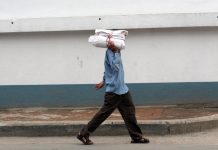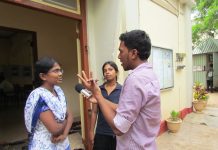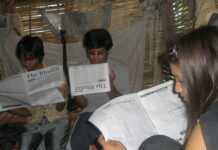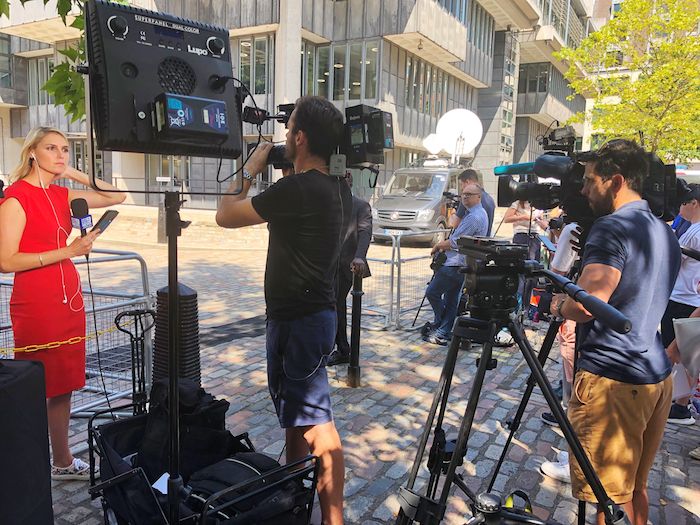
Planning is critically important in the news business. It’s the mark of professionalism and the essence of good coverage. But there are some things you can’t plan.
Big stories happen out of the blue. And when they do you have to spring into action immediately.
Your audience is counting on you to bring them the facts, quickly, and to answer all the questions that have immediately sprung into their minds.
They will be anxious for information – in some cases they might be worried that their loved ones are in danger.
You need to come up with high-quality, accurate, comprehensive reporting at a moment’s notice.
By definition you can’t be completely ready – you don’t know where, when or why the story is going to suddenly appear.
But there is a lot you can do to be prepared. And the old rule applies: fail to prepare, or prepare to fail.
The police and ambulance, fire and health services know this – that’s why they have rapid response teams or routines and resources that can be put quickly into place to deal with a major incident.
Just like the emergency services, the news media has a vital role to play when a big story happens. It is a time when the public turn to the media for good quality, accurate information.
So you need to be ready.
Media organisations should have their own versions of the rapid response team – a plan for how to use people, production teams, and communications to cover a big story. So what goes into the big story plan?
So what goes into a big story plan?
It is about ambition, organisation and the allocation of resources: people, equipment and space in your news product.
Ambition
In some ways this is the key to the whole exercise. You want to raise the effort, skills, production values and all-round performance of your team to the highest levels they have ever achieved. You can set an example by demonstrating your own energy, concentration, news judgement and determination to produce the very best content.
Space in the product
Depending on your product, you might need to:
- Order a bigger print run or extra editions
- Clear your radio or tv schedules for special programming
- Buy additional bandwidth so your website can cope with increased demand
People
One of your most important decisions is about the people. As in a World Cup final, you want to pick your best team to help you develop the plan.
Get them all together and tell them how you envisage it working. Take their input and go through scenarios: what if it involves personal danger? What if the big story happens in the middle of the night? What if it’s an environmental disaster and we can’t get to the scene? What if it de-stabilises the economy, or the country?
An important part of this preparation is to create the right calm and purposeful atmosphere that you need to prevail when the big story breaks. Journalists are human beings like everyone else and they will be equally shocked or appalled by what has happened, but they need to set that aside and operate in an objective, professional manner. The more you discuss the plan the better it will be.
Broadly, the roles and responsibilities can be split into two categories, Reporting and Production. Between those two categories sits a co-ordinating figure who has an overview of the entire operation. This can be the editor or someone else nominated for the task. The organisation chart looks like this:
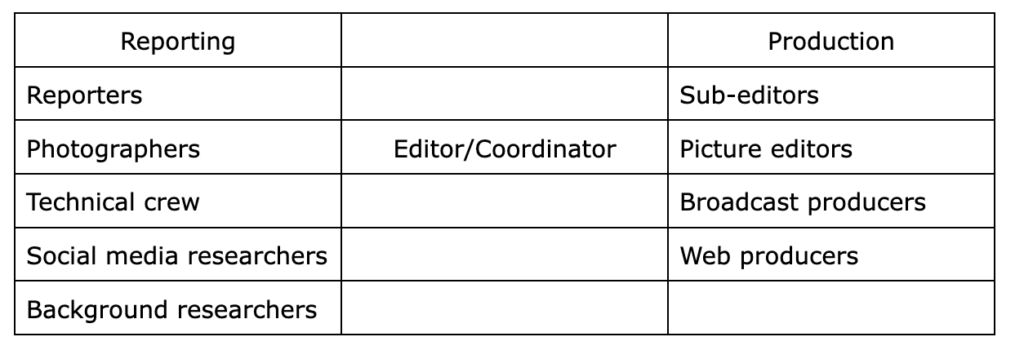
Equipment
Reporters, photographers and technical crew depend heavily on having the right equipment. They should each have a grab-bag with them at all times, ready to use on a big story. The grab-bag should contain:
- At least one power-pack to re-charge mobile phones
- Extra batteries
- Extra memory cards
- Flashlight
- Bad-weather clothing
- Extra leads and cables
- High-energy snacks
- Bottled water
- ID documents
- Press credentials if appropriate
- Equipment for hazardous environments if available and necessary
For video camera operators, this our additional checklist:
- Tripod
- Mini tripod for table-top use
- 2 x Lapel mics with long leads
- Wireless lapel mic with hotshoe receiver
- Stick mic
- Cable for stick mic
- Cables for connecting to PA systems
- IT cables (USB, HDMI, FireWire etc)
- Headphones
- White balance card
- Lens cloth
- Lenses
- Filters
- Reflector
- Extra lighting
- Spare batteries for camera and wireless mic
- Spare memory cards
- Rain cover
- Multitool
- Gaffer tape
- Logo cubes
Your company’s vehicles, if you have them, should be fuelled up after every story as a matter of policy, so they are always ready to go. If you do not have them you need a way of acquiring transport quickly.
Communications
Your coverage of the big story is entirely dependent on having good communications, so make sure everybody knows how they are supposed to talk to each other.
Mobile phones are the default tool and some news operations like to use a special WhatsApp group. But what if the story happens in an area where there’s no reception? Then you need a back-up plan, which might involve walkie-talkie radios or runners and vehicles to take messages and content back from the scene to a place where comms work properly.
On the day
The first requirement on a big story is to get to the scene as soon as possible. Before you team leaves, remind everybody that their personal safety comes first. There is no time to do a big risk assessment so they will have to rely on their judgement, experience and instincts, but you should make it absolutely clear that their safety is more important than getting the story.
The second requirement of your team arriving at the story is to file something, quickly, so that the team back in the office has some material to work with. It can be a short written report, a bit of audio, a still picture or video.
It is worth stressing the role of the reporter as the “eyes and ears” of your audience. Some of the most valuable reporting on any big story is the simple descriptive piece. This is often the best thing to file in the early stages.
While your team has been making its way to the scene, social media will be alive with reports, pictures and gossip about what’s happened. It will be a confusing mess and impossible for your audience to know what is correct and what is pure speculation or outright nonsense.
Your social media researchers need to be across all of the activity and help you identify useful and accurate material that can be built into your own coverage.
Meanwhile your background researchers should be looking into the context, using our module “Story development, ensuring all angles are covered” as a checklist, so they can provide you with vital elements that help explain the story.
All of the output from the reporting side should come through the co-ordinating figure, who maintains a picture of what is available, understands the challenges on the ground and deploys the team to fill any obvious gaps in the coverage.
The production team, meanwhile, should be changing the basic structure of your news product to reflect the importance of the big story. They have to find extra space and use it to create maximum impact.
They will be looking for the telling picture, the dramatic fact, the raw emotion or anything else that conveys the power and significance of the story.
They will also be the people calling the authorities to check the basic facts – a task that should not be left to reporters in the field.
This is where the news media differs from “citizen journalism”. Your job is to clarify, to end the confusion, to establish the firm facts and the relevant context.
When people turn to your coverage, you want them to know they can trust it, above all, to be accurate. No matter what is being said elsewhere, yours is the reliable source of information – the gold standard.
